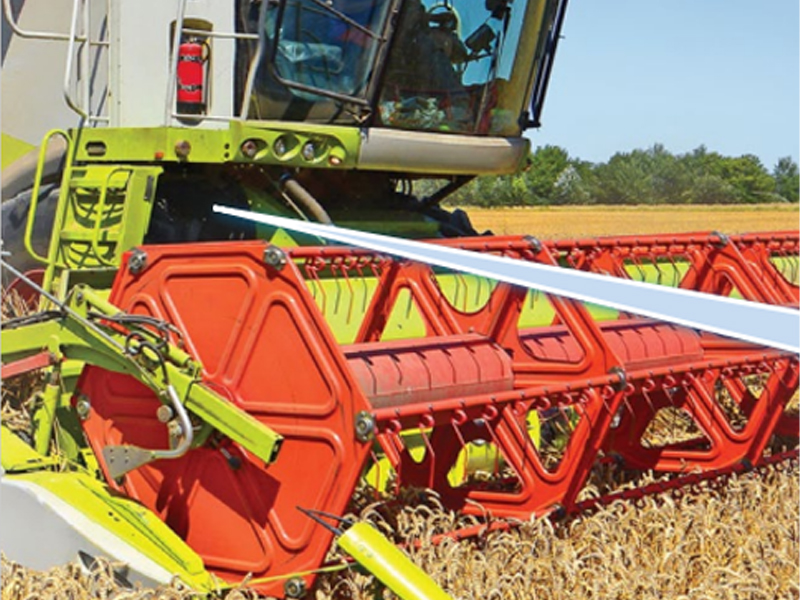Feeding a hungry world
As the world’s population grows, there is greater pressure on farms to produce enough food to meet growing demand. But farmers are facing increasingly difficult conditions due to the effects of climate change: heat waves, droughts, reduced yields, increased risk of floods and less arable land.
Meeting these challenges requires innovation and efficiency. This is where we can play a key role weighing scale load cell manufacturer as your partner, with our ability to apply innovative thinking and best practices to today’s agricultural needs. Let’s improve your operations together and help the world not go hungry.
Harvester grain tank weighing to accurately measure yield
As farms grow larger, farmers know they must understand how food yields vary in different growing areas. By analyzing many small plots of farmland, they can gain valuable feedback on which areas need extra attention to increase yields. To help with this process, we have designed a single-point load cell that can be installed in the harvester’s grain bin. Engineers then develop innovative software algorithms that allow farmers to interact with the load cells through communication protocols. The load cell collects force readings from the grain contained in the bin; farmers can then use this information to analyze yields on their fields. As a rule of thumb, smaller fields that produce larger force readings over a shorter period of time are indicative of better harvests.
Combine harvester tensioning system
Providing early warning and preventing costly damage, combine harvesters are extremely expensive and need to be on the field around the clock during harvest season. Any downtime can be costly, whether it’s equipment or farm operations. Since combine harvesters are used to harvest a variety of grains (wheat, barley, oats, rapeseed, soybeans, etc.), maintenance of the harvester becomes extremely complex. In dry conditions, these light grains pose little problem – but if it is wet and cold, or if the crop is heavier (e.g. corn), the problem is more complicated. The rollers will clog and take longer to clear. This can even lead to permanent damage. Driven Pulley Tensioner Driven Pulley Force Sensor to Measure Ideally, you should be able to predict blockages and prevent them from occurring. We created a sensor that does exactly that – it senses the tension of the belt and alerts the operator when the tension reaches dangerous levels. The sensor is installed near the main drive belt on the combine harvester side, with the loading end connected to the roller. A drive belt connects the driving pulley to the “driven pulley” that operates the main rotating threshing drum. If the torque on the driven pulley begins to increase, the tension in the belt will increase stressing the load cell. A PID (Proportional, Integral, Derivative) controller measures this change and the rate of change, then slows down the drive or stops it completely. Result: No drum clogging. The drive has time to clear the potential blockage and resume operations quickly.
Soil preparation/spreader
Spread seeds exactly in the right places Along with fertilizer spreaders, seed drills are one of the most important tools in modern agriculture. It allows farmers to cope with the severe impacts of climate change: unpredictable weather and shorter harvest seasons. Planting and seeding time can be significantly reduced with larger and wider machines. Accurate measurement of soil depth and seed spacing is critical to the process, especially when using larger machines that cover larger areas of land. It is extremely important to know the cutting depth of the front guide wheel; maintaining the correct depth not only ensures that the seeds receive the nutrients they need, but also ensures that they are not exposed to unpredictable elements such as weather or birds. To solve this problem, we have designed a force sensor that can be used in this application.
By installing force sensors on multiple robotic arms of a seeder, the machine will be able to accurately measure the force exerted by each robotic arm during the soil preparation process, allowing seeds to be sown at the correct depth smoothly and accurately. Depending on the nature of the sensor output, the operator will be able to adjust the depth of the front guide wheel accordingly, or the operation can be performed automatically.
Fertilizer spreader
Making the most of fertilizers and investments Balancing rising pressure to limit capital costs with the need to keep market prices low is difficult to achieve. As fertilizer prices rise, farmers need equipment that ensures cost-effectiveness and maximizes harvests. That’s why we create custom sensors that provide operators with greater control and accuracy and eliminate redundancy. The dosing speed can be easily adjusted according to the weight of the fertilizer silo and the speed of the tractor. This provides a more efficient way to cover a larger area of land with a specific amount of fertilizer.
Post time: Oct-11-2023








